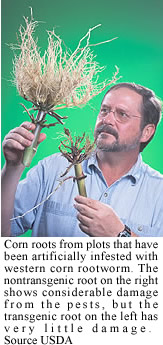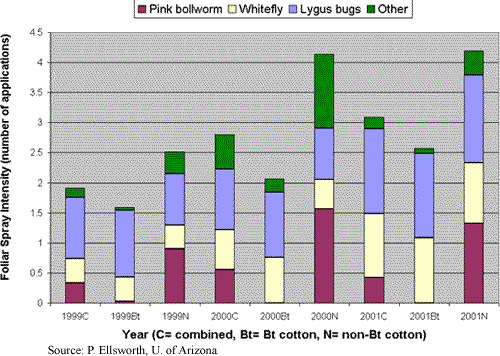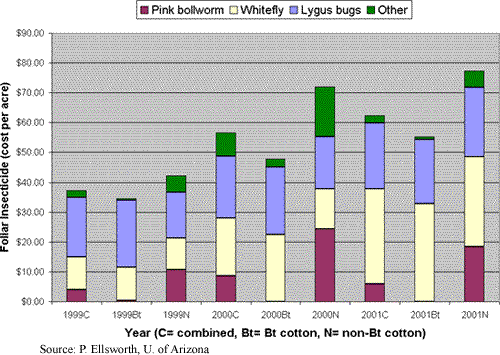 |
||||||||||||
 |
||||||||||||
Bt GM (genetically modified) crops
 Since
1996 plants have been modified with short sequences of genes from Bt
to express the crystal protein Bt makes. With this method, plants
themselves can produce the proteins without any external Bt and/or
synthetic pesticide sprays. In 1999, 29 million acres of Bt corn,
potato and cotton were grown globally. It has been estimated that by using
Bt protected cotton, the United States was able to save approximately
$92 million.
Since
1996 plants have been modified with short sequences of genes from Bt
to express the crystal protein Bt makes. With this method, plants
themselves can produce the proteins without any external Bt and/or
synthetic pesticide sprays. In 1999, 29 million acres of Bt corn,
potato and cotton were grown globally. It has been estimated that by using
Bt protected cotton, the United States was able to save approximately
$92 million.
Bt GM crops are protected specifically against European corn borer, southwestern corn borer, tobacco budworm, cotton bollworm, pink bollworm and the Colorado potato beetle. Other benefits attributed to using Bt include:
- Reduced environmental impacts from pesticides – When the plants are producing the toxins in their tissues there is no need to spray synthetic pesticides or apply Bt mixtures topically.
- Increased opportunity for beneficial insects – Bt will not kill beneficial insects.
- Reduced pesticide exposure to farm workers and non-target organisms.
Potential risks to using Bt:
- Invasiveness – Genetic modifications, through traditional breeding
or by genetic engineering can potentially change the organism to become
invasive. Few introduced organisms become invasive,
yet it’s a concern for the users.
- Resistance to Bt - The biggest potential risk to using Bt-crops is resistance. Farmers have taken many steps to help prevent resistance.
- Cross-contamination of genes - genes from GM plants can potentially introduce the new genes to native species.
GM Crop Data:
Combined, Bt Cotton and Non-Bt
Cotton Comparisons:
(Combined includes both Bt and non Bt acreages)

The use of Bt cotton has decreased the need for foliar spray on pink bollworm drastically. Overall Bt cotton requires less foliar spray than acres with no Bt cotton and acres with combination of Bt cotton and non Bt cotton.
